Looking to microbes for clean energy and water
October 30, 2009
Q&A with Bruce Rittmann
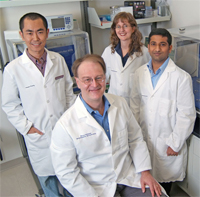
Dr. Rittmann with the Environmental Biology team that is studying the role of microorganisms in obesity
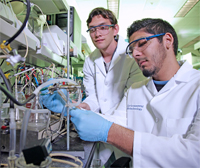
Environmental Biology research scientists setting up experiments with a microbial fuel cell
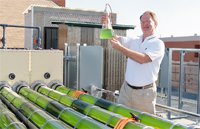
Dr. Rittmann sampling photosynthetic bacteria from the biofuels project “Tubes in the Desert”
Dr. Rittmann is Regents’ Professor of Civil and Environmental Engineering in the Ira A. Fulton Schools of Engineering, affiliated faculty of the School of Sustainability, and a member of the National Academy of Engineering. As director of the Center for Environmental Biotechnology at the Biodesign Institute, he has pioneered research on microbiological systems that generate usable energy from waste products and remove pollution from contaminated ecosystems.
What event or recognition focused your work on sustainability?
In the mid-1990s, I realized that sustainability is not about “the environment” or “the Earth,” but about the ability of human civilization to survive. Earth will fare well, and so will cockroaches, but will human society continue to exist? Should it? Balancing our deplorable record of destruction with our great works of art, music, architecture, and engineering, I decided humanity is worth the effort, so I made sustainability an explicit part of my research.
What is the most important sustainability-related research project you are currently working on?
Our society’s addiction to fossil fuels is the root cause of most environmental problems. Intoxicated by hundreds of millions of years of stored-up energy to draw upon, we have built a society that depends on coal, petroleum, and natural gas for up to 86 percent of its energy. This cannot be sustained. Therefore, my most important project studies how to use photosynthetic bacteria to capture sunlight and CO2 and convert it into a form of renewable biofuel that can replace fossil fuel.
Why do you believe microbes are the key to sustainability solutions?
Bacteria can grow 100 times faster than plants and do not compete for arable land or consume and pollute our water resources. With a working large-scale microbe-based system, we could generate enough renewable energy to replace the world’s fossil-fuel use in a total area roughly equal to Texas. Microbes can provide other services as well. In our lab we are developing microbe-based systems that can purify contaminated water and increase our usable water supplies.
How do you think your sustainability-related research can affect policy decisions?
Once policymakers realize it is possible to replace fossil fuels without harming our food supply or water resources, we can focus on global cooperation instead of competition over fossil fuels. I expect some push-back from entities with vested interests in fossil fuels, but society has no choice but to move steadily over the next 20 or so years towards an energy supply that is predominantly clean and renewable.
What is the world sustainability challenge that concerns you most?
Global climate change is the most difficult technical challenge because fossil fuel use permeates every aspect of our society and we are way behind in finding solutions. What worries me most, though, is that war and terrorism may overrun civilization if we cannot find technological solutions fast enough.
October 30, 2009


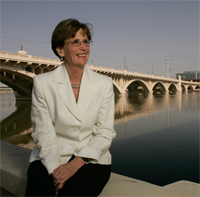
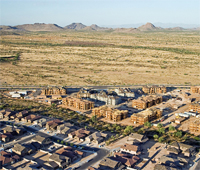
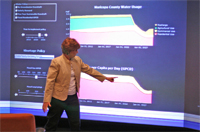
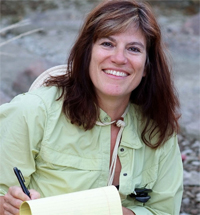
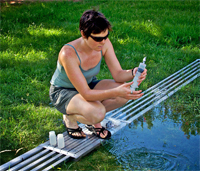
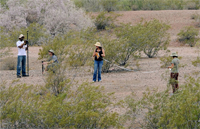
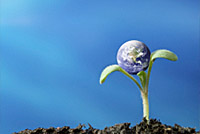 Working in conjunction with APS Energy Services (APSES), the liberal arts campus tucked in the northwest corner of Phoenix is going green with a major interior and exterior lighting retrofit. The six-month project, scheduled for completion in December, will improve the quality of lighting in offices, classrooms and public areas and reduce the overall energy demand and consumption of the campus.
Working in conjunction with APS Energy Services (APSES), the liberal arts campus tucked in the northwest corner of Phoenix is going green with a major interior and exterior lighting retrofit. The six-month project, scheduled for completion in December, will improve the quality of lighting in offices, classrooms and public areas and reduce the overall energy demand and consumption of the campus.
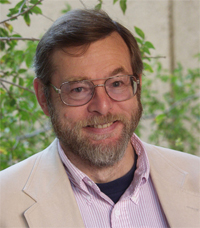
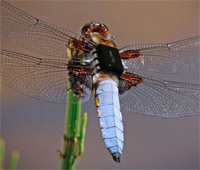
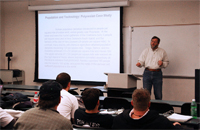
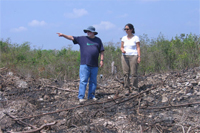
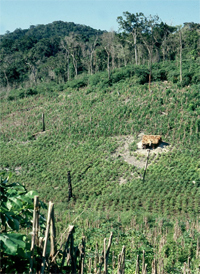
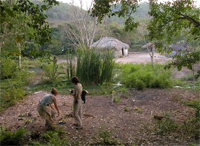
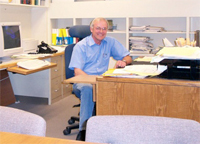
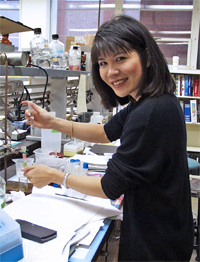

 ASU Surplus Property has identified Zero Waste as an area that we believe can have a big impact on for ASU and the environment. Evaluating our trash tonnage over the past years led us to believe that we could make substantial contributions to this goal with new uses for discarded material. We evaluated various areas in the operation and found opportunities to reduce waste and increase revenue.
ASU Surplus Property has identified Zero Waste as an area that we believe can have a big impact on for ASU and the environment. Evaluating our trash tonnage over the past years led us to believe that we could make substantial contributions to this goal with new uses for discarded material. We evaluated various areas in the operation and found opportunities to reduce waste and increase revenue. ASU Surplus waste tonnage for January 1, 2007 through April 30, 2007 was 46.93 tons. Waste tonnage for the same period this year was 20.16 tons. This is a reduction in waste of 26.77 tons which equates to a 57% decrease. The savings in landfill fees was $1,873.63. Projecting these numbers for the year we come up with a total cost savings of $5,620.90 totaling 80.31 tons of material diverted from the landfill. These new recyclables are made up of metals; cardboard and paper to a lesser degree. A majority of the items removed from the waste stream are recycled with some being sold for reuse.
ASU Surplus waste tonnage for January 1, 2007 through April 30, 2007 was 46.93 tons. Waste tonnage for the same period this year was 20.16 tons. This is a reduction in waste of 26.77 tons which equates to a 57% decrease. The savings in landfill fees was $1,873.63. Projecting these numbers for the year we come up with a total cost savings of $5,620.90 totaling 80.31 tons of material diverted from the landfill. These new recyclables are made up of metals; cardboard and paper to a lesser degree. A majority of the items removed from the waste stream are recycled with some being sold for reuse.